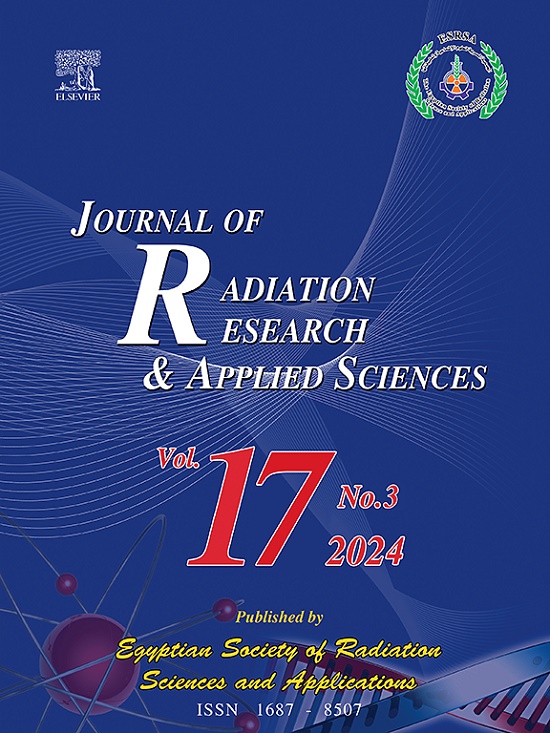用于预测乳腺癌预后、免疫浸润和药物反应的癌相关成纤维细胞相关lncRNA信号的构建
IF 2.5
4区 综合性期刊
Q2 MULTIDISCIPLINARY SCIENCES
Journal of Radiation Research and Applied Sciences
Pub Date : 2025-06-13
DOI:10.1016/j.jrras.2025.101685
引用次数: 0
摘要
癌症相关成纤维细胞(CAFs)相关长链非编码rna (lncRNAs)是癌症进展的关键参与者。本研究旨在建立一个与caf相关的lncRNA标记来预测乳腺癌预后、免疫浸润和药物反应。方法下载乳腺癌相关公开资料。筛选关键的cafna相关lncRNA,建立cafna相关lncRNA预后特征。评估了该特征的临床应用,并通过将预后特征与临床因素相结合建立了nomogram。对不同风险组进行免疫细胞浸润分析、药物敏感性分析和基因集富集分析(GSEA)。此外,利用定量PCR (qPCR)验证了特征lncRNAs在5种乳腺癌细胞系中的表达。结果乳腺癌标本中scaf水平升高,高CAF标本预后较差。通过8个与ca相关的预后lncrna构建预后特征,包括LINC00844、SENCR、NR2F2-AS1、HAND2-AS1、MIR31HG、cacna1c - as1、LINC01120和LINC00626,具有较高的预后性能,在训练和验证数据集中的AUC值分别为0.844(0.949,0.705)和0.742(0.828,0.614)。然后,建立了预后nomogram,该nomogram具有较高的生存预测准确率和临床应用价值。预后特征与免疫细胞浸润,特别是CD8+ T细胞和M2巨噬细胞,对AZD7762和顺铂等几种药物的反应以及包括细胞周期在内的差异途径有关。此外,qPCR证实乳腺癌细胞中LINC00844、SENCR、NR2F2-AS1、HAND2-AS1、MIR31HG、cacna1c - as1表达降低,LINC01120、LINC00626表达升高。结论建立了一个强大的ca相关lncRNA特征,为预测乳腺癌预后和优化治疗策略提供了有价值的见解。本文章由计算机程序翻译,如有差异,请以英文原文为准。
Construction of a cancer-associated fibroblast-related lncRNA signature for forecasting the prognosis, immune infiltration and drug response of breast cancer
Objective
Cancer-associated fibroblasts (CAFs)-associated long-non coding RNAs (lncRNAs) are key players in cancer progression. This study intended to develop a CAF-related lncRNA signature to forecast breast cancer prognosis, immune infiltration and drug response.
Methods
The breast cancer-related public data were downloaded. Key CAF-related lncRNAs were screened for establishing the CAF-related lncRNA prognostic signature. The clinical utility of this signature was evaluated, and a nomogram was established by combining prognostic signature with clinical factors. Furthermore, immune cell infiltration analysis, drug sensitivity analysis, and Gene Set Enrichment Analysis (GSEA) of different risk groups were conducted. Besides, the expression of signature lncRNAs was validated in five breast cancer cell lines utilizing quantitative PCR (qPCR).
Results
CAF levels were increased in breast cancer samples and samples with high CAF levels had poor prognosis. A prognostic signature was built by eight CAF-related prognostic lncRNAs, including LINC00844, SENCR, NR2F2-AS1, HAND2-AS1, MIR31HG, CACNA1G-AS1, LINC01120, and LINC00626, which had a high prognostic performance, with AUC value of 0.844 (0.949, 0.705) and 0.742 (0.828, 0.614) in training and validation datasets, respectively. Then, a prognostic nomogram was established, which had high survival prediction accuracy and clinically useful. The prognostic signature was related to immune cell infiltration, particularly CD8+ T cell and M2 macrophage, response to several drugs like AZD7762 and cisplatin, and differential pathways, including cell cycle. Besides, qPCR confirmed the reduced expression of LINC00844, SENCR, NR2F2-AS1, HAND2-AS1, MIR31HG, and CACNA1G-AS1 and elevated expression of LINC01120 and LINC00626 in breast cancer cells.
Conclusions
A robust CAF-related lncRNA signature was developed, offering valuable insights into forecasting prognosis and optimizing therapeutic strategies for breast cancer.
求助全文
通过发布文献求助,成功后即可免费获取论文全文。
去求助
来源期刊

Journal of Radiation Research and Applied Sciences
MULTIDISCIPLINARY SCIENCES-
自引率
5.90%
发文量
130
审稿时长
16 weeks
期刊介绍:
Journal of Radiation Research and Applied Sciences provides a high quality medium for the publication of substantial, original and scientific and technological papers on the development and applications of nuclear, radiation and isotopes in biology, medicine, drugs, biochemistry, microbiology, agriculture, entomology, food technology, chemistry, physics, solid states, engineering, environmental and applied sciences.
 求助内容:
求助内容: 应助结果提醒方式:
应助结果提醒方式:


